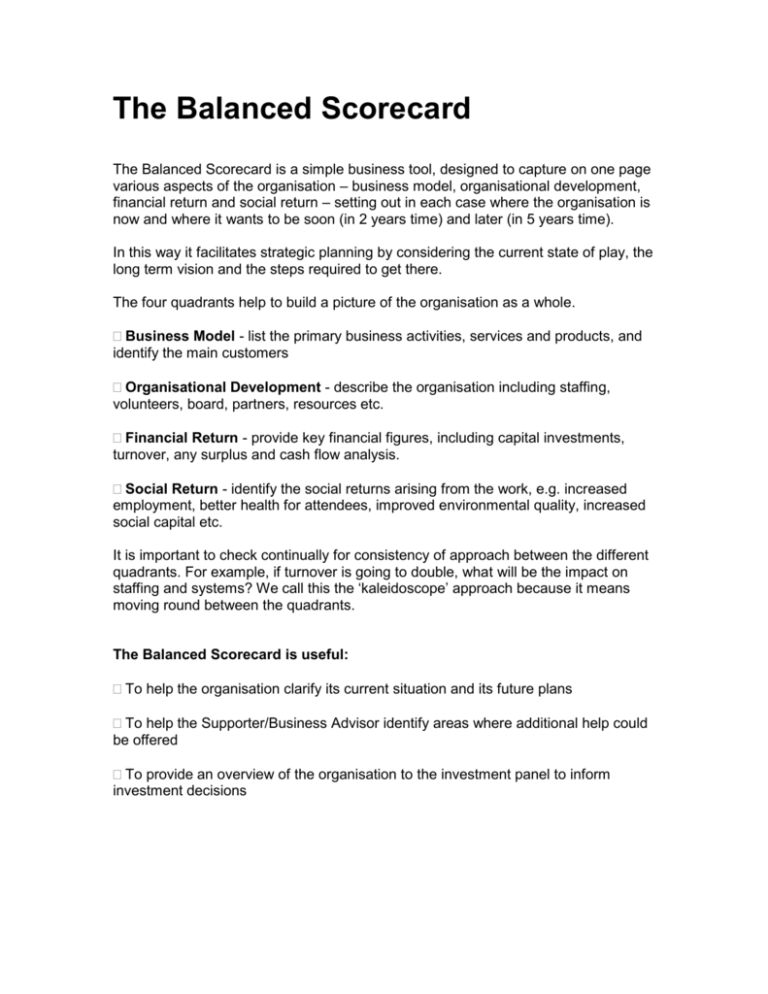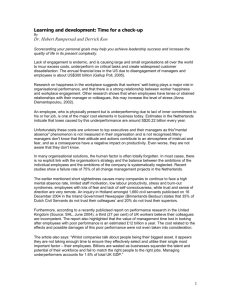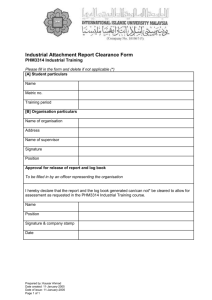The Balanced Scorecard - Community Action Derby
advertisement

The Balanced Scorecard The Balanced Scorecard is a simple business tool, designed to capture on one page various aspects of the organisation – business model, organisational development, financial return and social return – setting out in each case where the organisation is now and where it wants to be soon (in 2 years time) and later (in 5 years time). In this way it facilitates strategic planning by considering the current state of play, the long term vision and the steps required to get there. The four quadrants help to build a picture of the organisation as a whole. Business Model - list the primary business activities, services and products, and identify the main customers Organisational Development - describe the organisation including staffing, volunteers, board, partners, resources etc. Financial Return - provide key financial figures, including capital investments, turnover, any surplus and cash flow analysis. Social Return - identify the social returns arising from the work, e.g. increased employment, better health for attendees, improved environmental quality, increased social capital etc. It is important to check continually for consistency of approach between the different quadrants. For example, if turnover is going to double, what will be the impact on staffing and systems? We call this the ‘kaleidoscope’ approach because it means moving round between the quadrants. The Balanced Scorecard is useful: To help the organisation clarify its current situation and its future plans To help the Supporter/Business Advisor identify areas where additional help could be offered To provide an overview of the organisation to the investment panel to inform investment decisions . The Balanced Scorecard aims to predict a journey that the organisation is going on. Some of the markers in this journey are numeric (e.g. turnover increases from 50k to 75k to 100k). Others are narrative (e.g. short lease is converted to long lease with aspiration for freehold transfer). Along the way, copies of the Balanced Scorecard can be permanently saved as snapshot reminders of plans and progress for the organisation. Organisations making longer-term investment propositions may need to vary these timescales to fit their business model. What information should be entered into the Balanced Scorecard? OVERALL Remember the Balanced Scorecard is about the organisation as a whole rather than a specific project or enterprise. BUSINESS MODEL Standard requirements (now/soon/later) Description of primary market(s) – who are the customers List of primary business activities – what are the services and products that attract earned, contract, grant income, showing turnover for each? Additional optional indicators Eg market share (locally) Hints and Tips Encourage participants to cluster their activities into groups – eg ‘basic skills training’ or ‘support to smaller groups’ Identify who they are ‘selling’ these products to – the user? the local authority? trust funds? Which markets are likely to grow or shrink? What new products or services are planned? What is the competition? Against whom might the organisation benchmark? ORGANISATIONAL DEVELOPMENT Standard requirements (now/soon/later) Description of organisational form/when established People – number and skill assessment of Directors/Trustees, number of staff/volunteers Key partnerships Buildings/land (ownership or management) Early Warning Guide indicators (green, amber, red) Organisational quality tool achieved (Pquasso, Visible, DTA HealthCheck, ISO etc) Additional optional indicators Eg number of local members, accreditation, acquisitions/mergers, trading subsidiaries. Hints and Tips This quadrant is most in need of the kaleidoscope approach to check internal consistency is the form of the organisation appropriate for the business activities? if the business model is going to change, do the people have appropriate skills? if growth is projected in the business/financial quadrants how will the organisation need to develop to maintain capacity? are the quality systems in place to measure the proposed social returns? are the premises suitable for the proposed activities? SOCIAL RETURN Standard requirements (now/soon/later) Description of social aim (primary beneficiaries/area of benefit/population/summary of overall social objective) Number of local people using facilities over a year (of which, those from the organisation’s target minority groups) Number of local organisations supported over a year Social impact tool in use or proposed. Additional optional indicators Only select those capable of measurement through social impact tool Hints and Tips Strangely this is often where participants can struggle – they need to define what actually is the benefit that will result from activities Who are the beneficiaries? How many are there? How do they benefit? Encourage participants to think outcome and impact, rather than output. What other benefits accrue to the community, the state etc? Think social, economic, environmental, cultural benefits. What might be measured, and how? FINANCIAL RETURN Standard requirements (now/soon/later) Turnover Percentage of earned or contract income (compared to grant income) Annual surplus/deficit Reserves (restricted and unrestricted) Value of assets (restricted and unrestricted) Additional optional indicators Eg diversification of income streams, financial return on assets Hints and Tips Should be mostly quantified (rather than eg ‘increased turnover’). Encourage participants to predict changes in these figures, even if they are rough estimates. Beware of simplistic growth models. Consider the quality and diversity of income streams - length of contract, security of funding source, gross margin, etc. © Development Trusts Association 2009 33 Corsham Street, London, N1 6DR, tel: 0845 458 8336, fax: 0845 458 8337, email: info@dta.org.uk, website: www.dta.org.uk A company limited by guarantee registered in England no: 2787912. A registered charity no: 1036460








